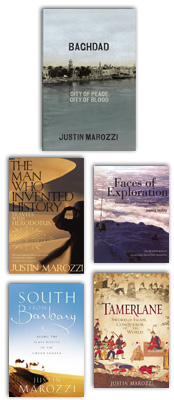JUSTIN MAROZZI FROM YPRES
December 2008
Just past midnight on 11 November, the Menin Gate of Ypres is quiet and still. Even the rain, a constant companion on any winter visit to Flanders, falls silently. The peace is disturbed only by an occasional passer-by trotting past, collar upturned against the weather, or a car slipping quickly through the gate, wipers working overtime.
The heart of the night is a good time to arrive at one of the greatest memorials of the Great War. In a few hours, it will be impossible to get close as the town commemorates the 90th anniversary of the Armistice.
Although officially this is a gate, it is so broad many visitors consider it a tunnel. The reason the Menin Gate is so deep is to accommodate the names of 54,896 missing British and Commonwealth soldiers who lost their lives in the Ypres Salient, a Dantean hell of noise, mud, blood and slaughter from 1914-1918.
The missing men remembered here are a small fraction of the several hundred thousand killed in this corner of Belgium. They came from a very different Britain, from long-vanished regiments like the 57th Wilde’s Rifles, Lord Strathcona’s Horse and the Duke of Wellington’s Regiment, augmented by imperial forces from India such as the 35th Sikhs, 40th Pathans and the 9th Bhopal Infantry.
Flanders Fields Museum, a stone’s throw from the Menin Gate in the vast Grote Markt square, gives a disturbing picture of what it was like to live and fight in the Ypres Salient in this “war to end all wars”. Paul Nash, the English war artist, called it “one huge grave”: “unspeakable, godless, hopeless”. “I am a messenger who will bring back the word from the men who are fighting to those who want the war to go on forever,” he wrote in 1917. “Feeble, inarticulate will be my message, but it will have a bitter truth, and may it burn their lousy souls.”
By mid-morning, the crowds are lining Meensestraat several deep to get a glimpse of the veterans’ parade and service beneath the Gate. Joining the townsfolk and the largely British visitors are the immaculately turned out veterans. Hundreds of bereted Brits, Belgians, Kiwis and Canadians, as well as Indians in yellow turbans. Medals glimmer and helmets shine in the oozing rain. Waxed moustaches bristle to attention. Those unable to get near the Gate gather under umbrellas in front of a giant screen in Grote Markt.
Benoît Mottrie is chairman of the Last Post Association, which organises the town’s daily honouring of the war dead. Every evening at 8 o’clock, the traffic is stopped beneath the Menin Gate to allow the buglers to sound their mournful tribute.
The clock sounds 11 o’clock. Mottrie gives a moving speech in which he rebuffs recent suggestions that with the Great War receding from personal experience into distant history, it may be time to review the daily act of remembrance. They have sounded the Last Post 27,569 times since 1928, he reminds the crowds. Were they to sound it for every life lost, they would be busy until 2610.
“It is only right and proper that sacrifice on this scale should be remembered,” he says. “Our debt of honour to the past has not yet been paid.” It will be properly discharged “only when people learn to resolve their differences peaceably”.
One by one, suited dignitaries lay wreaths in the heart of the memorial. The Gate is flanked by an expanse of sodden, scarlet poppies, a “Flanders Field” organised by the Royal British Legion. The famous lines from Laurence Binyon’s Ode to the Fallen – “At the going down of the sun, and in the morning / We will remember them” – are written on the petals, with messages of support on the back. “May we never forget your sacrifice and hope that men soon cease to wage war,” a typical one reads.
Back at the St George’s Church Hall, the British veterans are tucking into post-parade beers. The room is filled with a strong sense of British decency and dignity. Most veterans see remembrance at Ypres as an essential way of honouring both those who have served this country and those who serve in distant wars today. “To us as ex-servicemen, Ypres is where the whole tradition of remembrance begins,” says Eddie Hefferman, a trustee of the Royal British Legion.
Yet one can wonder where, if anywhere, remembrance takes us, beyond the simple honouring of the war dead. Siegfried Sassoon despised the Menin Gate and what it represented. “Well might the Dead who struggled in the slime / Rise and deride this sepulchre of crime,” he wrote.
Another veteran in the church hall admits he has “mixed feelings” about remembrance. “You see people laying wreaths while our soldiers are being killed in Iraq and Afghanistan. We just never seem to learn. I don’t think we’re doing enough to frighten the younger generation away from war.”
Remembrance alone can never curb man’s instinct for war. It is as inherent as his need to defecate. Without memory, though, we would be even worse at restraining this primeval urge to fight. One takes away a sense of “never again” defiance, however futile, from the many memorials and oceans of white headstones in Flanders. Perhaps, as Benoît Mottrie suggests, collective remembrance becomes more, rather than less, important as those who fought in the Great War pass away.
Several miles north-east of Ypres, Tyne Cot Cemetery marks the final resting place of a further 35,000 British and New Zealand soldiers, most of them killed in the nightmarish Passchendaele Offensive around Ypres. One of the headstones is particularly striking. It belongs to Second-Lieutenant Arthur Conway Young, of the Royal Irish Fusiliers, killed on 16 August, 1917, at the age of 26. He was, says the inscription, “sacrificed to the fallacy that war can end war”.

